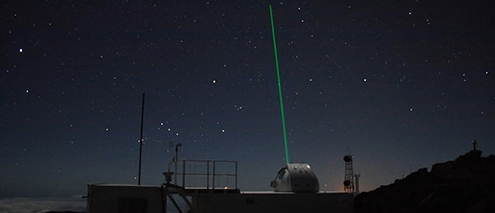How can we learn more about planets and moons? Dominic Dirkx recently wrote his PhD dissertation on a new method of accurately measuring the distance between the earth and satellites orbiting or on planets and moons to within between a millimetre and a centimetre. Current radio measurements are accurate to about a metre.

Dirkx took laser tracking, a technique that’s currently used for measuring the distance to earth’s satellites (accurate to within a few millimetres), and extrapolated that to interplanetary distances. His research primarily shows that it’s vital that we not only measure the distance extremely accurately. Other measurements will also need to be improved in order to make the most effective use of laser tracking. If we manage to do that, this method can potentially play an important role in the exploration of our solar system. That might sound obvious, but his research has shown that focusing on making laser measurements and measurements of elements such as magnetic fields, shape or a planet’s seismic activity more accurate can really have a significant impact on your results.
Influence of the clock on earth
When trying to improve laser measurements, Dirkx asked to what extent the ultimate measurements are influenced by the clock we use here on earth. Dirkx: ‘When you measure distance, you’re actually measuring movement. You use a clock on earth and a clock in space to measure how long a laser pulse is en route. Because you know what the speed of light is, you look to see where a satellite is from one moment to the next. And that means that if you’re just a nanosecond out, it can easily make 30 centimetres difference.’
If you examine how something moves, you examine how gravity works and as such, you learn about the surroundings. Imagine that you measure how a satellite orbits the planet Mars: that will allow you to find out more about the composition of the planet. Last year, for example, this method was used – alongside other measurements – to discover an ocean under the surface of Enceladus, a moon of the planet Saturn.
A remarkable thesis defence
Dirkx graduated nominally and with distinction. David Smith (MIT) felt it was worth the trip to Delft to sit on the committee during his thesis defence. Smith is specialised in laser ranging as well as planetary sciences. Dirkx: ‘He’d worked with colleagues from our research group in the past, and I’d met him at conferences. He’s someone who’s extremely intimidating to doctoral candidates – a major figure with an endless list of significant publications to his name.’
Dirkx: ‘What really helped during my promotion was having the opportunity to work on the European FP7 ESPaCE project. This enabled me to build up a large network, so I’ve always had lots of people to discuss my research with. My tip for other PhDs is therefore to talk to people whenever you can. Not only within your own research group, but particularly outside of it.’